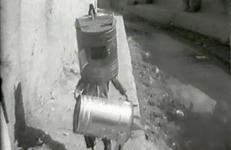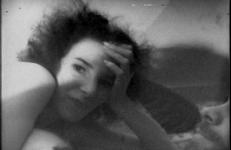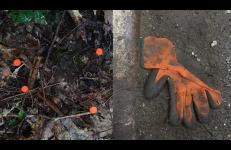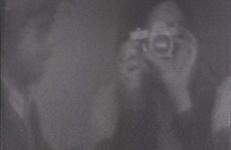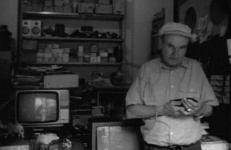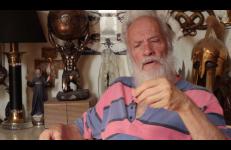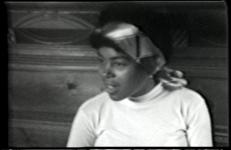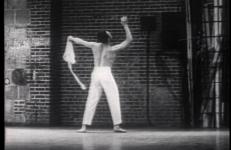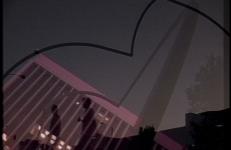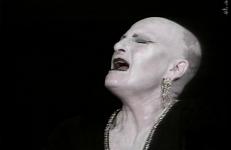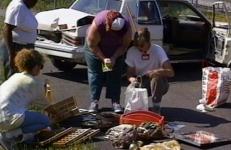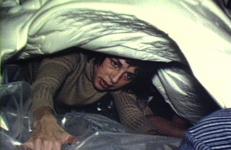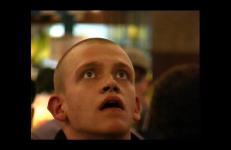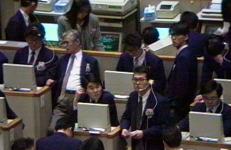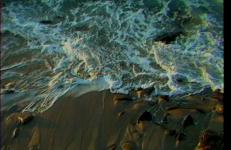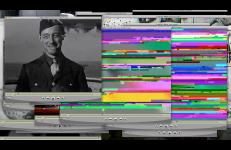This video was produced as a part of Eiko & Koma's exhibition Time is not Even, Space is not Empty which opened at the Zilkha Gallery in Wesleyan University in the fall of 2009. Edited by Eiko with assistance of Tara Kelton and Shoko Letton, 38 Works shows the trajectory of Eiko & Koma's career through short excerpts of most of their works created between 1976 (the year they arrived in the US) and 2009 (the year they started the Retrospective Project).
Documentation
A son discreetly records fleeting moments in his parents’ suburban home. An intimate portrait of a stable life lived according to the rules of society.
In 1972 Eric Siegel, an early pioneer of video art, set out on an extreme adventure driving from Europe six thousand miles overland to India. He was one of the first people to use the revolutionary new technology from Sony Corporation, the Portapak. This was the first small portable video camera/recorder combo that was the predecessor of today’s camcorders. Together with his friend Anthony they documented the trip. This video is the portion of the trip that took them through Afghanistan, one of the most exotic places along the way.
An early example of video erotica from the Videofreex. A group of naked people lounge around smoking and listening to music. A male and female couple is making love on the floor in a room full of monitors.
For over two years we made it our business to document abandoned working gloves on the streets of NYC. The feelings and thoughts that surrounded this activity connected to the ways his family relates to Gregor Samsa as a cockroach, or whatever Franz Kafka intended him to be in The Metamorphosis after his transformation from a productive citizen to a useless insect. When Gregor can't grant them a comfortable life-style any longer, his family starts to resent and hate the once loved and respected provider, finds him disgusting.
This title documents the participation of artist Aldo Tambellini at the opening of the 1970 exhibition Vision and Televison. Held at the Rose Art Museum of Brandeis University in Waltham, Massachusetts from January 21st to February 22nd, the exhibition is widely regarded as the first museum exhibition of artist's video. Tambellini (b. 1930) was a pioneer of expanded media in the 1960s, and one of the first artists to use video and television as a medium.
The title is comprised of the following Videofreex reels:
A portrait of an unnamed city in Italy. Sidestepping the tourist attractions that make the city famous, the film/video posits an almost-imaginary place that draws closer to the reality of its inhabitants. Using a voiceover narration that collages direct observation, literary texts, historical fact, local folklore, and a bit of sheer fabrication, the film/video melds documentary and narrative, past and present.
An intimate portrait of the artist at his home in San Francisco, this film delves into Mike Kuchar's life and work. The artist portrait explores, among other things, Kuchar's movie/music collections, his mysterious Casablanca editing system and the comic books, religious iconography and sci-fi memorabilia that fill the apartment floor to ceiling.
Animated Contingencies is an animated documentary that looks at how sketches take the place of photography in courtroom settings. Andrews focuses on how two different representations, a photograph and a courtroom sketch, capture the moment Moses Wright, Emmett Till's uncle, pointed out Till's murders while on the witness stand at their trial. The work then examines the authority of photographic evidence and how animated representations can provide both visibility and anonymity in testimony and other contexts.
In October 1969, the Videofreex visited the home of wealthy political and social activist, Lucy Montgomery, as she was hosting the Black Panther Party of Chicago during one of their most fraught times – the period just after Chairman Bobby Seale was wrongfully imprisoned for inciting riots at the Democratic National Convention a year earlier. This video documents an interview with the wife of Bobby Seale, Artie Seale.
This video features California artists: drawer and painter Deanne Belinoff, sculptor and poet Sana Krusoe, wood relief carver and painter Palema Holmes, and New York-based video artist Shirley Clarke.
The Artists: Part 1 was produced in concert with the exhibition Four Solo Exhibitions at the Long Beach Museum of Art in 1988. The artists are introduced by LBMA’s senior curator Josine Ianco-Starrels. The video presents and contrasts the diverse styles, media, and personalities of these four women artists.
This video profiles the work and insight of California artists: sculptor, painter, and installation artist Laddie John Dill and painter and sculptor Clark Walding. It also includes a mini-documentary on Tony Delap’s The Big Wave, a public art sculpture that crosses Wilshire Boulevard in Santa Monica.
Part 3 profiles three California women artists: sculptor and lint and installation artist Slater Baron, mixed media installation artist Beverly Nadius, and book artist Sue Ann Robinson.
This tape compiles three profiles of performance artists: A Creative Synthesis: George Coates Performance Works (10:00), The Performance World of Rachel Rosenthal (16:00), and Paul Dresher Ensemble (08:00).
Aura of IEVE, edited by Phil Morton, is video documentation of the first Interactive Electronic Visualization Event (IEVE) at the University of Illinois Circle Campus. Unlike IEVE Aura, which features the image processed and audio synthesized video from the event, the camera instead focuses on the artists creating the video: Tom DeFanti on the Digital Keyboard (computer), Dan Sandin on the Image Processor, and Bob Snyder on the sound keyboard.
This project on family violence, spanned two years and several sites across the country, and involved wrecked cars in sculptural installations. The cars were reconfigured by women and children who suffered violence at the hands of loved ones. Linked to each other through common experience, women from a domestic violence shelter in Pittsburgh, a family violence program at Bedford Hills prison, children from shelters in Niagara Falls and Cleveland, teenage girls in Oakland, and politicians on Staten Island all collaborated in making the cars.
Feminist artist Lynda Benglis is known for her sculptures, video performances, paintings, and photography. Her work in the 1970s was controversial, delving into issues of gender roles within and outside the art world. Produced in conjunction with her retrospective at the High Museum of Art in Atlanta, Dual Natures provides an introduction to Benglis’s work and includes excerpts from her videos of the mid-’70s and footage of the artist at work.
Berlin Zoo is a video loop set in the train station and terminal interface of the same name. Several bystanders were captured by the artist’s camera as they are gradually overcome by a general state of disbelief – of shock and awe even – while staring upwards at the arrivals and departures timetables. This gallery of grimaces is intertwined with an eerie soundtrack of wind blowing and occasional squawks of birds. Berlin Zoo could be classified as a fake documentary on the contemporary wildlife of a metropolis, an exercise in modern day ornithology.
Between the Frames is a series that offers a glimpse into contemporary history that is already past, a portrait of personalities and opinions shaping what and how art reaches a public forum.
The Collectors: Between the Frames, Chapter 2
Art collectors offer various explanations of why and what they acquire. With Herman Daled, Robert Rowan, Eric and Sylvie Boissonas, Giuseppe Panza di Biumo, Marcia Weisman, Fernando Vijande, Bob Calle, Acey and Bill Wolgin, Gianni Rampa, Isabel de Pedro, Rafael Tous, and Toshio Ohara.
Between the Frames is a series that offers a glimpse into contemporary history that is already past, a portrait of personalities and opinions shaping what and how art reaches a public forum.
The Critics: Between the Frames, Chapter 6
Big_Sleep™ explores problems in our archival urges. Via a single-channel desktop screencast, informatic elements ebb and flow—creating and relating interface absences. These gaps suggest that no amount of hard drive space can defy mortality.
Big_Sleep™ explores problems in our archival urges. Via a single-channel desktop screencast, informatic elements ebb and flow—creating and relating interface absences. These gaps suggest that no amount of hard drive space can defy mortality.
Performance engineers Survival Research Laboratories (SRL) construct machines that live in their own fictional world, acting out scenarios of perpetual torment, exasperated consumption, and tragic recognition. This film presents a fractured narrative featuring these large anthropomorphic robots and represents Jonathan Reiss and SRL’s collaborative desire to go beyond the restraints of event documentation.
Marielle Nitoslawska’s Breaking the Frame is a feature–length profile of the radical New York artist Carolee Schneemann. A pioneer of performance art and avant-garde cinema, Schneemann has been breaking the frames of the art world for five decades by challenging the taboos leveled against the female body. Breaking the Frame is a kinetic, hyper-cinematic intervention, a critical medita-tion on the intimate correlations animating art and life.
Praise for Breaking the Frame:






